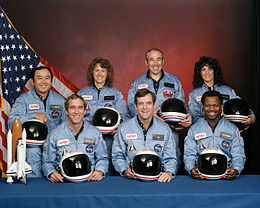73 seconds. That was the flight time of the final flight of STS-51L, the Challenger. The doomed Space Shuttle lifted off from Cape Canaveral, Florida at 11:39 local time on 28 January 1986. It was the first fatal accident of an American space craft in flight.
Francis R. Scobee, Commander, Michael J. Smith, Pilot, Ronald McNair, Mission Specialist, Ellison Onizuka, Mission Specialist, Judith Resnik, Mission Specialist, Gregory Jarvis, Payload Specialist and Christa McAuliffe, Payload Specialist and teacher were all killed.

The disaster was caused by the failure of the two redundant O-ring seals in a joint in the Space Shuttle’s right solid rocket booster (SRB). The record-low temperatures of the launch reduced the elasticity of the rubber O-rings, reducing their ability to seal the joints. The broken seals caused a breach into the joint shortly after liftoff, which allowed pressurized gas from within the SRB to leak and burn through the wall to the adjacent external fuel tank. This led to the separation of the right-hand SRB’s aft attachment and the structural failure of the external tank. Following the explosion, the orbiter, which included the crew compartment, was broken up by aerodynamic forces.
The crew compartment and many other vehicle fragments were recovered from the ocean floor after a three-month search-and-recovery operation. The exact timing of the deaths of the crew is unknown; several crew members are known to have survived the initial breakup of the spacecraft. By design, the orbiter had no escape system, and the impact of the crew compartment at close to 200 mph with the ocean surface was too violent to be survivable.
The disaster led to a 32 month hiatus in Shuttle flights and the creation of the Rodgers commision by President Reagan. The commision faulted NASA’s organizational culture and decision-making processes. As early as 1977 the issues with the SRB O-rings were known, yet NASA failed to address the issues. It also came out that NASA managers also disregarded warnings from engineers about the dangers of launching in cold temperatures and did not report these technical concerns to their superiors.
The Space Shuttle fleet was grounded for two years and eight months while the program underwent investigation, redesign, and restructuring. On September 29, 1988, Discovery launched on STS-26 mission from LC-39B with a crew of five veteran astronauts. Its payload was TDRS-3, which was a substitute for the satellite lost with Challenger. The launch tested the redesigned boosters, and the crew wore pressure suits during the ascent and reentry. The mission was a success, and the Space Shuttle program resumed flying.
There wouldn’t be another accident until the Columbia broke apart on re-entry on 1 February 2003.
